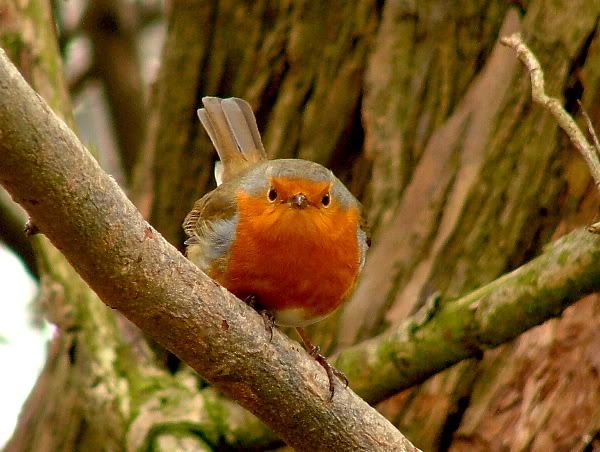A good couple of days for us, best bird undoubtedly being the Great Grey Shrike at Ogston Reservoir, Derbys. Whatever the books might say about Shrikes perching atop bushes is wrong! Elusive is hardly the word, skulking barely covers it any better, nonetheless we did get two decent views of the bird in flight. It looked a little smaller than one might expect, but otherwise unmistakable.
Our sympathies went out to an older couple of local bird club members, they arrived two minutes after the Shrike gave the only half hour showing of the day, and promptly thereafter searched hard, so hard they tired and retreated to their car for a nap. As you might imagine, this was when the bird was again visible. There's a moral in that somewhere.
Seemed like plenty of other birders attracted by reports of the Shrike missed out too as for much of the day it remained deeply in a thicket. It is perhaps very telling that for a regional mega that's been around for a couple of weeks now the only photograph of it is very distant indeed. If that doesn't impress, I'm happily quoting the local bird news websites that say it's the first Shrike on site since 1978, so perhaps you'll forgive my boasting?
Also got my first Little Ringed Plover of the year, to go with the Wheatear I found at the old pit yesterday. Good time to be out and about anywhere.
Saturday, 31 March 2007
Wednesday, 28 March 2007
Hoveringham by Sea
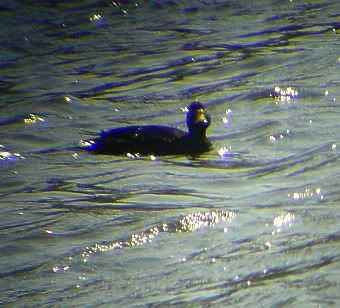
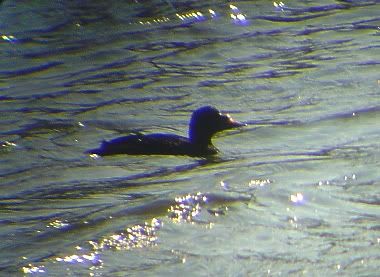 Rough digiscopes, hopefully you can see the impressive structure of the Scoter's bill.
Rough digiscopes, hopefully you can see the impressive structure of the Scoter's bill.Headed out for that Red-necked Grebe at Hoveringham on Sunday to no avail, seems it moved on to the next town along the river. Disappointment was staved off though by the Common Scoter on the Trent, a top bird for the county. As much as they are known to make nocturnal movements over land in the Spring, we just don't see many of them at all. Really handsome ducks too, coal black all over.
Directing other birders to the individual drake was a happy way of breaking the bad news about the Grebe.
52 species for the day, including my first two Sand Martin for the year, a pair of Oystercatcher on the river bank, and a column of 7 Buzzard in one thermal. More bizarrely was a bat, Pipistrelle so far as I could tell, fighting the winds in the broad daylight of mid-afternoon.
And yesterday at the old Pleasley Pit I scored bird #100 for my carbon neutral list. The first Redshank, a pair actually, I've seen at the still developing site that looks more promising for waders with every visit. Meadow Pipit have suddenly become very vocal there, catching up with the Skylark that have been displaying for well over a month.
Labels:
birding,
hoveringham,
Nottinghamshire,
scoter,
trent
Sunday, 25 March 2007
City Visit
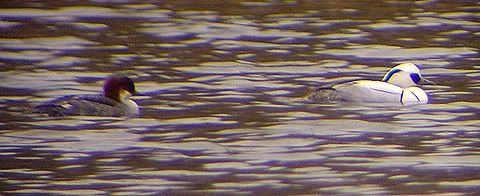 The girlfriend wanted to go into Nottingham to shop at the Chinese supermarket, so to make a trip out of the drive I suggested we visit Colwick Country Park, one of the top 10 sites in the county, one with plenty of good reports.
The girlfriend wanted to go into Nottingham to shop at the Chinese supermarket, so to make a trip out of the drive I suggested we visit Colwick Country Park, one of the top 10 sites in the county, one with plenty of good reports.Can't be disappointed either, Smew are star birds any day and a nice yearly tick. True to form they were on the smaller lake where the trees overhang the bank. Ever glamourous as they are, as a child I always thought of the drake as being like that fancy ice-cream with the chocolate swirls in it.
Elsewhere the park was quiet, good birds, if nothing so spectacular - Goldeneye, Chiffchaff, large mixed flocks of Linnet and Reed Bunting, and I heard a Lesser Spotted Woodpecker drumming, as per usual for the bird, heard but not seen. 46 species in all.
Labels:
birding,
birdwatching,
city,
colwick,
Cormorant,
digiscoping,
Nottinghamshire,
smew
Friday, 23 March 2007
Wandering Guillemots
Here's a strange thing, my brother tells me that on his journey home from a week-long rangering course in the Peak District he saw two Guillemot, on a river in deepest Derbyshire, confirmed by the other ranger he was travelling with.
And I thought I did well with my Ringed Plover the other day!
These Spring gales sure can bring up some surprises.
And I thought I did well with my Ringed Plover the other day!
These Spring gales sure can bring up some surprises.
Parakeets, a changing tide?
The pair of Stock Dove are back in our garden again, very happy to have them too. Some days I'll wait half an hour to do any gardening if they've flown in for a feed.
Couldn't help noticing a BBC News feature about the burgeoning Ringed-necked (or Rose-ringed) Parakeet population in the south of England.
Generally I'm of the opinion that British conservation can no longer really settle on ignoring the issues surrounding invasive non-native species. If we've learnt nothing else from Grey Squirrel, American Signal Crayfish, etc, it's that introducing exotic species of animal (and indeed plant) very seldom has the ecologically neutral impact we might hope for.
Even if the parakeets don't clash with any one particular bird species, I don't see how we can welcome a new competitor for nest holes and bird tables when the pressures some British bird populations have already caused significant declines in the last several decades, and I'm not sure it sets a very good precedent if we encourage their continuing presence. After all, what foreign species comes next?
The birds themselves are a memorable spectacle, but I think if we're really honest we know they don't belong here.
What I'm less sure about is whether the Environment Agency, conservation groups or the public, have the stomach to do what would be needed to remove these most characterful birds from the wild in Britain.
Couldn't help noticing a BBC News feature about the burgeoning Ringed-necked (or Rose-ringed) Parakeet population in the south of England.
Generally I'm of the opinion that British conservation can no longer really settle on ignoring the issues surrounding invasive non-native species. If we've learnt nothing else from Grey Squirrel, American Signal Crayfish, etc, it's that introducing exotic species of animal (and indeed plant) very seldom has the ecologically neutral impact we might hope for.
Even if the parakeets don't clash with any one particular bird species, I don't see how we can welcome a new competitor for nest holes and bird tables when the pressures some British bird populations have already caused significant declines in the last several decades, and I'm not sure it sets a very good precedent if we encourage their continuing presence. After all, what foreign species comes next?
The birds themselves are a memorable spectacle, but I think if we're really honest we know they don't belong here.
What I'm less sure about is whether the Environment Agency, conservation groups or the public, have the stomach to do what would be needed to remove these most characterful birds from the wild in Britain.
Wednesday, 21 March 2007
Ready Redpoll
Bird of my day has to be (Lesser) Redpoll, clearly a pair and giving great views as they flitted down into a ditch to bathe. I'd cycled to the park to put out some seed, not really planning on spending too much time in the gales and the snow. Delightful sight though, and it gives hope that they might breed this year.
They've been only a winter finch around here lately, so a pair staying on this long might just stay the course. I hope so, Redpoll is one species tumbling in numbers at the moment. They are one of my favourite species too, so stout and smart, looking charmingly officious to me, like a 1950's postman or something.
Heron was nice too, plus its shimmering reflection on the small water.
I thought twice about attempting to photograph any of these birds, I wouldn't want to discourage either by getting too close at this time of the year.
Yellowhammer seemed to have paired off too, indeed only the House Sparrow are staying together in a still sizeable and quite vocal flock.
No Little Owl today, they clearly no better than to perch out in this weather.
They've been only a winter finch around here lately, so a pair staying on this long might just stay the course. I hope so, Redpoll is one species tumbling in numbers at the moment. They are one of my favourite species too, so stout and smart, looking charmingly officious to me, like a 1950's postman or something.
Heron was nice too, plus its shimmering reflection on the small water.
I thought twice about attempting to photograph any of these birds, I wouldn't want to discourage either by getting too close at this time of the year.
Yellowhammer seemed to have paired off too, indeed only the House Sparrow are staying together in a still sizeable and quite vocal flock.
No Little Owl today, they clearly no better than to perch out in this weather.
Labels:
birding,
Brierley Forest Park,
Nottinghamshire,
redpoll
Saturday, 17 March 2007
First Willow Warbler of the Year
Got down to the local nature reserve today to get in an hour's bird count so I could refresh the sightings board and give visitors an idea of what sort of birds to expect. The short time meant covering only about half of the park, nonetheless we got in 33 species, nice birds too like Linnet, Redpoll, Bullfinch and Yellowhammer, and one or two commoner birds like Moorhen and Kestrel refused to show for the hour.
Without doubt, bird of the day had to be a very confiding Willow Warbler. I half hoped for Chiffchaff, which didn't show, I hardly count myself as disappointed though.
There seem so many signs of an earlier Spring at the moment. Also, the Redwing seem to have all gone, probably about time they did.
Without doubt, bird of the day had to be a very confiding Willow Warbler. I half hoped for Chiffchaff, which didn't show, I hardly count myself as disappointed though.
There seem so many signs of an earlier Spring at the moment. Also, the Redwing seem to have all gone, probably about time they did.
Wednesday, 14 March 2007
As Spring Gets Earlier...
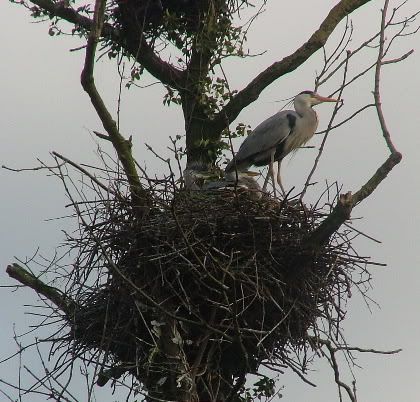 Mild astonishment down at my local reservoir. In the heronry there is a nest with chicks grown enough to be exercising their wings! They look to be at least three weeks old, which considering the incubation period of the eggs mean the parent birds mated and laid in mid-to-late January. Can you believe that? Through the heavy snow and ferocious gales we've had since then, that nest, those eggs and the chicks survived it all. Amazing.
Mild astonishment down at my local reservoir. In the heronry there is a nest with chicks grown enough to be exercising their wings! They look to be at least three weeks old, which considering the incubation period of the eggs mean the parent birds mated and laid in mid-to-late January. Can you believe that? Through the heavy snow and ferocious gales we've had since then, that nest, those eggs and the chicks survived it all. Amazing.Then, there are the other signs that Spring is arriving, like these courting Great Crested Grebe. Immediately after the pair skulked into some reeds, they like to keep the climax to themselves.
Video - Great Crested Grebe Mating
Labels:
birding,
grebes,
heron,
heronry,
kings mill reservoir,
Nottinghamshire
Thursday, 8 March 2007
Scauped
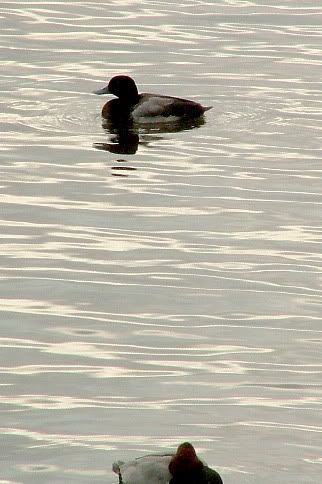 The 1st-winter Scaup that's been hanging around my local reservoir for a couple of months now is really beginning to chill out. First of all it stayed determinedly in the middle, like any self-respecting sea duck should, as far from passersby as possible. Now, now it's happy to roost in the day with the Tufted Duck and Pochard right under the hanging trees of the bank.
The 1st-winter Scaup that's been hanging around my local reservoir for a couple of months now is really beginning to chill out. First of all it stayed determinedly in the middle, like any self-respecting sea duck should, as far from passersby as possible. Now, now it's happy to roost in the day with the Tufted Duck and Pochard right under the hanging trees of the bank.I'll be sad to see the bird go. Okay, he's a bit scruffy, still striking though.
Not a bad bird either, to say the reason I went there was to walk my baby niece.
Hoped for some early hirundines over the water, House or Sand Martin, none yet though. Probably for the best in retrospect, it's still chilly out there.
Labels:
birding,
Cormorant,
kings mill reservoir,
Nottinghamshire,
robin,
scaup
Tuesday, 6 March 2007
Blacktoft Sands RSPB
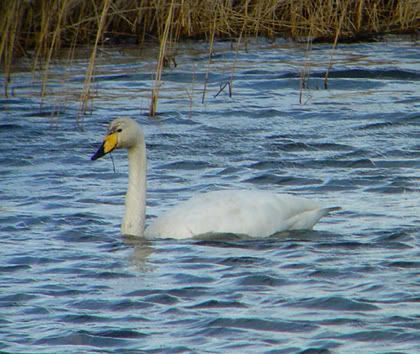 Another visit to Blacktoft Sands (East Yorksire) for my girlfriend's last day of freedom before her new job. We hoped for Avocet since several hundreds are apparently wintering nearby on an island in the middle of the Humber. The daytime tides weren't on our side though, and none of the birds felt pushed inland to the lagoons at Blacktoft. Avocet should breed their again in the Spring though.
Another visit to Blacktoft Sands (East Yorksire) for my girlfriend's last day of freedom before her new job. We hoped for Avocet since several hundreds are apparently wintering nearby on an island in the middle of the Humber. The daytime tides weren't on our side though, and none of the birds felt pushed inland to the lagoons at Blacktoft. Avocet should breed their again in the Spring though.Still Marsh Harrier always show well there, and a number of local rarities were nice sightings too, including Whooper Swan and Pintail.
The main waders were present, Black-tailed Godwit, Dunlin, Curlew, Lapwing, Redshank and Golden Plover, but nothing special to pick out among them.
Barn Owl are usually a good bet, not on windy days like this one though, and try as we might, waiting until dusk didn't pick one up for us.
Video - Marsh Harrier sailing on the wind
Still, a good day, nice birds, 62 species.
Labels:
birding,
blacktoft sands,
east yorkshire,
marsh harrier,
RSPB,
whooper swan
Subscribe to:
Posts (Atom)


